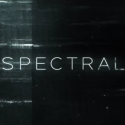My first thought of this movie would describe it as Ghostbusters meets Halo.
The film opens on a soldier named Davis, a special forces operative on his own trying to evade some kind of formidable force. Back up will take up to eight minutes according to his radio. He keeps moving. There are bodies everywhere, soldier and civilian, fallen as if stopped dead in their tracks. Davis comes upon a strange ghost-like entity, which he quickly learns is invisible to the unaided eye. Thanks to some neat goggles he can see the ghost as clear as day. As he’s trying to make sense of what he’s looking at the entity sees and rushes him. Upon making physical contact with the entity Davis falls backward and appears just like the poor bodies he just passed.
So about those neat goggles that enabled Davis to see the apparition meet its inventor Dr. Clyne, played by James Dale (World War Z, Iron Man 3). A top-notch DARPA engineer (those folks who build cutting-edge tech toys for the US Military) that just made a functioning microwave-emitting ray gun capable of flash-boiling an enemy’s water-supply, and, potentially, humans; arguably the best kind of scientist there is since he’s not afraid of getting dusty in the field. Stephen Root (The Man In The High Castle, Office Space) cameos as Clyne’s colleague Dr. Mindala who informs Clyne that General Orland, played by Bruce Greenwood (Star Trek, I, Robot), needs Clyne’s help to try and make sense of the apparition Davis saw. Clyne is on the first flight to Moldova where there’s civil unrest between an ousted regime containing cells of insurgents, and some seriously pissed off citizens.
Upon clearing a CIA checkpoint wherein Clyne promises never to discuss what Uncle Sam is about to show him General Orland provides Clyne the playback from Davis’ goggles. Whatever these things are they’re only visible in hyper-spectral (or ultraviolet) wave-lengths; hence the title. This leads us to the scene that makes me like Clyne’s character so much. While the hard-nosed CIA operative Fran Madison, played by Emily Mortimer (Shutter Island, Formula 51), is desperate to provide answers to a shaken Washington, DC she speculates on fanciful theories of active camouflage (cloaking tech). Clyne provides a grounded sense of looking for a more practical answer. “Everyone is biased,” about how they reach answers. I swear that should be a mantra for scientists. Since Agent Madison needs to be able to provide more definitive information to her superiors she asks Clyne what he’ll need to make a better guess. “A better shot,” he says. Let’s get back into the field!
Since all the spec-forces soldiers have merely the specialized goggles to help them see the spectrals Clyne brings along a giant camera that uses the same spectrum tech as the goggles. It’s basically a huge CCTV camera that’s to be mounted on a tank. Once in the field the soldiers get to put these spectrals to barrage of tests including learning that all conventional ammunition, explosives, and body armor are useless against these things. As soon as one of the soldiers confronts a spectral and engages it he is taken down instantly, the skin of his face has the same trauma to it that the other bodies Davis saw from earlier in the movie; like they were frozen to death in an instant. One after another these spectrals take down numerous soldiers by mere touch. There are tons of these things, over 15. What’s more interesting than how the spectrals kill or how many of them there are is how they move: almost identical to how we expects ghosts to move (through walls and such).
Realizing that this latest mission has turned into a suicide-run the order is given to retreat, but not before at least half the Delta Force team is taken down. On their way out their tanks get hit by a few landmines and are rendered useless. They take refuge in an abandoned building only a few blocks from their first location. It’s here they learn a great deal more about how to put these spectrals down. Apparently these things are not impervious to all elements of the battle field. Pure iron shows to be a deterrent when it’s discovered there’s a barrier of iron filings surrounding the building they’ve just taken refuge in. Using the special camera Clyne brought from DARPA they learn that these things cannot walk or move on Iron. Within the same building they find two kids who have been orphaned. Clyne and the soldiers learn that the kids’ father seems to have known a few things about the creatures such as iron and ceramic are two materials that these things definitely do not like.
While the soldiers are losing their heads over planning their escape Clyne comes up with the idea to weaponise all the iron in the building — there’s tons of it! Dirty bombs to the rescue! Clyne also devises a way to convert his special camera (the one that was retro-fitted to go on the tank) into a spectral flash-light. Just as the team is preparing to head out of the building Clyne aims his new flashlight at the building across the street from them. The creatures are smart. They figure out how to use the power-lines between buildings to circumvent the iron barrier surrounding the building with the soldiers and kids. Fortunately, the iron-bombs and upgraded munitions seems to be holding some of the spectrals back.
Now it’s in this chase sequence that some of the plot breakdown begins to occur. Since the spectrals can only be seen with the high-range spectrum flashlight we can still see spectrals chasing the soldiers and kids even though the special flashlight is facing in the opposite direction. An argument could be made that it’s the periphery of the beam (like how a flashlight can illuminate a room even though the beam is focused on a finer point), but that’s a reach.
Delta Force, Dr. Clyne, Agent Madison, and the kids make it to the extraction point; tanks arrive on scene to provide cover fire. What the newly arrived soldiers don’t know is how useless their conventional munitions are against the spectrals. As you can imagine another bloodbath ensues. This scene was the one where I felt like these things really are evil in the sense that until this point the spectrals only attacked soldiers who engaged them first. One of the two kids is in the thick of the fight looking for a piece of ceramic his father and sister gave to him to keep him safe from the spectrals. Out of nowhere a spectral kills the unarmed boy. Yeah, by then I was in agreement with Delta Force that all spectrals must die!
Once the chopper arrives to extract the survivors Clyne gets the momentous idea to take the bandoleer he made of glass-jars filled with iron-filings and smashes it to the ground. The kick-up of wind from the chopper’s main rotor sends all the filings at the spectrals keeping them away from the chopper. Nice move!
By the time they’re all extracted and taken to another location it becomes time to regroup and rethink how to take these seemingly invulnerable entities down. Clyne to the rescue, again! In the words of Andy Weir by way of Mark Whatney, he scienced the shit out of the problem!! He ultimately deduces that these things are a synthetic state of matter. We are all familiar with the three most common known states of matter: solid, liquid, and gas. We are also familiar with the fact that materials can be in one state, and with application of certain temperatures, become another. Water can be frozen into ice, metal can be melted into liquid, and so forth. Just like we can synthesize certain materials (ie: Polyester is a clothing material that doesn’t occur in nature) we can also synthesize states of matter. Clyne proposes that the spectrals are a form of Bose-Eintsein condensate (BEC). Well, it’s me. You can bet I did some research to make sure the writers weren’t just lobbing the Hollywood equivalent of a hail-mary throw in football. Sure enough BEC is real. One way to think of it is if you were to collect the condensation that occurs on the outside of sports drinks or Cokes on a warm day, super-cool it so it’s only a few degrees above absolute zero, and give it a degree of intelligence you have these spectrals. And like the Mythbusters’ hosts say before every episode, “Don’t try this at home.”
Upon deducing what the beings are they also find that you cannot create the condensate without massive amounts of energy to get the matter into BEC form. Interestingly enough there’s a power-plant not far from their current location. To take on the being Clyne suggests that the weapons they’ve been using up till then are simply inadequate (D’uh moment), but he quickly explains that they can make pulse-weapons that will break up the condensate. Another thing Clyne got right, apply enough energy to something and you can just as easily break it down as you could making it to begin with. Energy can be as destructive as it can be constructive.
With the new information Clyne not only upgrades their weapons and tools, but also helps make new body-armor for everyone to wear… ceramic armor! So with new armor, weaponry, and some robotic “dogs” that have the spectral-goggles for heads the remaining US forces converge on the home of these things. With the first test fire of one of their larger blasters the new munitions with upgraded components prove successful as a spectral comes at the soldiers, tries to go through a single spectral-missile, and gets vaporized. The weapons all work, but these creatures are very quick learners. While the new munitions might slow down the spectrals it doesn’t fully eliminate them, and what’s more is these things can move fast!
Clyne and Madison make it to the heart of the complex where the spectrals came from; an assembly plant was using a combination of 3D printing with the BEC as the medium, and the central nervous system of many of the assembly plant workers to create the spectrals ability to move.
Clyne and Madison quickly locate the centralized heart of these creatures. Wouldn’t you know the story line starts coming straight out of a grossly predictable alien sci-fi movie (ie: the first Independence Day). Cripple the giant array of umbilical cords and all the beings breakdown. Clyne’s only character flaw comes in this moment where he almost forgets the last step in shutting the heart down.
This movie is pretty clever as story-lines go. If you’re a Netflix subscriber it’s a two-hour flick that I feel does as well as most stories. The science is solid (always a plus for me), the characterizations and dialogue are plausible enough, a more than decent cast on top of all that. There were a handful of inconsistencies, but nothing that would make you want to walk away. If you like a good military movie where the scientist gets due respect, and the soldiers aren’t complete hard-asses this movie should be entertaining enough.






